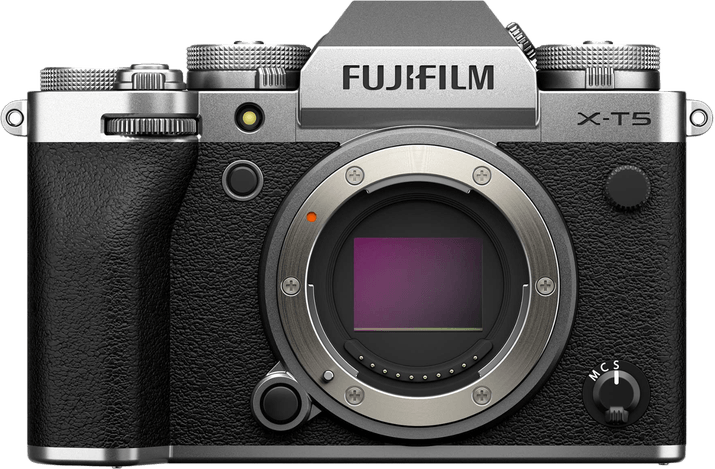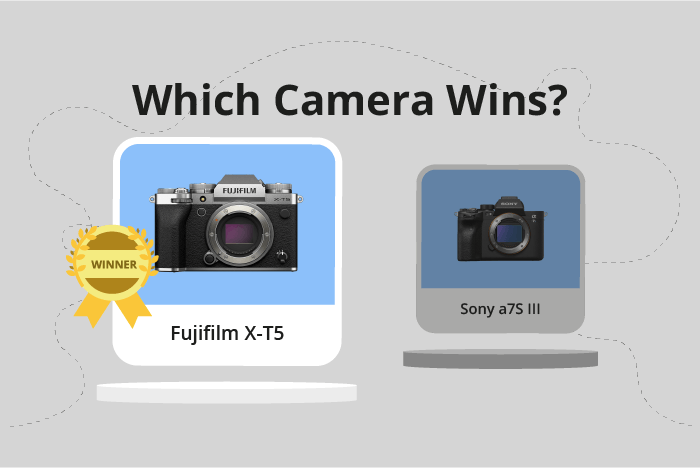Fujifilm X-T5 vs Sony a7S III Comparison
Fujifilm X-T5

Sony a7S III

The Fujifilm X-T5 outperforms the Sony a7S III with a score of 81/100 compared to 74/100. Both cameras are mirrorless and have similar sizes, with the X-T5 measuring 130 x 91 x 64mm and the a7S III at 129 x 97 x 81mm. However, the X-T5 is lighter, weighing 557g (1.23lbs), while the a7S III weighs 699g (1.54lbs).
The X-T5 has a lower launch price of $1699, making it more affordable than the a7S III, which has a launch price of $3499. Additionally, the X-T5 is newer, having been announced in 2022, whereas the a7S III was announced in 2020.
Although the Sony a7S III has a higher launch price and is slightly heavier, it may offer some advantages in terms of features or performance that justify the difference. However, based on the scores and general specifications, the Fujifilm X-T5 is the better option, offering a more recent release and a more budget-friendly price without sacrificing quality.
Fujifilm X-T5 vs Sony a7S III Overview and Optics
The Fujifilm X-T5 triumphs over the Sony a7S III in optics with a score of 81/100 compared to 69/100. Both cameras share similarities, such as having a CMOS sensor, image stabilization, and a similar lens mount system – the Fujifilm X for the X-T5 and the Sony FE for the a7S III.
The X-T5 outperforms the a7S III in key aspects. Its 40-megapixel resolution significantly surpasses the 12.1-megapixel resolution of the a7S III, resulting in more detailed and sharper images. The X-T5 also boasts a faster shooting speed of 15 frames per second, enabling it to capture fast-moving subjects with ease. Furthermore, the X-T5 utilizes the advanced X-Processor 5, which delivers faster image processing and improved performance.
On the other hand, the Sony a7S III has its own advantages. Its full-frame sensor, compared to the X-T5’s APS-C sensor, allows for better low-light performance and a shallower depth of field. Additionally, the a7S III has a DXOMARK score of 86, indicating its strong sensor performance. However, it is important to note that DXOMARK does not score Fujifilm cameras, so a direct comparison is not possible.
In terms of optics, the Fujifilm X-T5 emerges as the winner with its superior resolution, shooting speed, and processing power. The Sony a7S III, while falling short in these categories, still offers advantages in low-light performance and depth of field due to its full-frame sensor. Ultimately, the choice between these cameras depends on the user’s specific needs and preferences.
Fujifilm X-T5 vs Sony a7S III Video Performance
The Fujifilm X-T5 outperforms the Sony a7S III in video capabilities, scoring 87/100 compared to the Sony’s 77/100. Both cameras share some common video specifications, but there are key differences that make the Fujifilm X-T5 superior.
Both cameras offer high-quality video recording, but the Fujifilm X-T5 takes the lead with its 6K maximum video resolution and dimensions of 6240×4160. In contrast, the Sony a7S III has a 4K maximum video resolution and dimensions of 3840×2160. This means that the Fujifilm X-T5 delivers higher resolution and larger video dimensions, resulting in more detailed and sharper video footage.
Another advantage of the Fujifilm X-T5 is its built-in time-lapse functionality. This feature allows users to create time-lapse videos directly from the camera without the need for additional software or equipment. The Sony a7S III, on the other hand, lacks this built-in feature.
However, the Sony a7S III does have an edge in terms of maximum video frame rate, offering 120fps compared to the Fujifilm X-T5’s 60fps. This higher frame rate allows for smoother slow-motion video capture and more flexibility in post-production.
Taking these factors into account, the Fujifilm X-T5 proves to be the better option for videographers seeking higher resolution and built-in time-lapse functionality. The Sony a7S III may appeal to those who prioritize higher frame rates for slow-motion capture. Each camera has its strengths, and the choice depends on individual preferences and requirements.
Fujifilm X-T5 vs Sony a7S III Features and Benefits
The Fujifilm X-T5 outperforms the Sony a7S III in features with a score of 85/100 compared to 83/100. Both cameras share several common specifications, including a 3-inch screen size, touchscreen, flip screen, and a lack of GPS. Additionally, both models offer WiFi and Bluetooth connectivity.
The Fujifilm X-T5 excels in screen resolution, boasting 1,840,000 dots compared to the Sony a7S III’s 1,440,000 dots. This higher resolution provides a clearer and more detailed display, allowing for better image review and menu navigation.
The Sony a7S III, despite its slightly lower feature score, may still be preferable for some users. It shares many of the same essential features as the Fujifilm X-T5, and the lower screen resolution might not be a deciding factor for everyone. The Sony a7S III is still a strong contender with a competitive feature set.
When considering these two cameras, potential buyers should weigh the importance of the higher screen resolution offered by the Fujifilm X-T5. If this aspect is crucial, the X-T5 is the superior choice. However, if other factors such as general specifications, optics, and video capabilities are more important, the Sony a7S III remains a viable option. Both cameras are well-equipped with modern features, and the ultimate decision lies in the user’s priorities and preferences.
Fujifilm X-T5 vs Sony a7S III Storage and Battery
The Fujifilm X-T5 and Sony a7S III both have a storage and battery score of 76/100, indicating equal performance in this category. Both cameras offer two memory card slots and support USB charging. However, there are differences in the memory cards accepted and battery life.
The Fujifilm X-T5 accepts SD, SDHC, and SDXC cards (UHS-I compatible), whereas the Sony a7S III accepts SD, SDHC, and SDXC cards (UHS-II compatible) and CFexpress Type A cards. The Sony a7S III has a slight advantage in terms of memory card compatibility.
In terms of battery life, the Fujifilm X-T5 provides 580 shots with its NP-W235 battery, while the Sony a7S III offers 600 shots with its NP-FZ100 battery. The Sony a7S III outperforms the Fujifilm X-T5 in this aspect.
Both cameras have their strengths and weaknesses in storage and battery features. The Sony a7S III offers better memory card compatibility and a slightly longer battery life. The Fujifilm X-T5, however, still provides a decent battery life for most users. Ultimately, the choice between these two cameras depends on individual preferences and needs.
Fujifilm X-T5 vs Sony a7S III – Our Verdict
Are you still undecided about which camera is right for you? Have a look at these popular comparisons that feature the Fujifilm X-T5 or the Sony a7S III:

